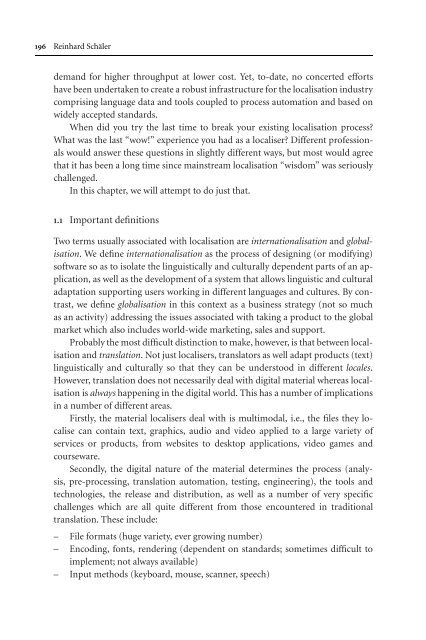Topics in Language Resources for Translation ... - ymerleksi - home
Topics in Language Resources for Translation ... - ymerleksi - home
Topics in Language Resources for Translation ... - ymerleksi - home
- No tags were found...
You also want an ePaper? Increase the reach of your titles
YUMPU automatically turns print PDFs into web optimized ePapers that Google loves.
196 Re<strong>in</strong>hard Schälerdemand <strong>for</strong> higher throughput at lower cost. Yet, to-date, no concerted ef<strong>for</strong>tshave been undertaken to create a robust <strong>in</strong>frastructure <strong>for</strong> the localisation <strong>in</strong>dustrycompris<strong>in</strong>g language data and tools coupled to process automation and based onwidely accepted standards.When did you try the last time to break your exist<strong>in</strong>g localisation process?What was the last “wow!” experience you had as a localiser? Different professionalswould answer these questions <strong>in</strong> slightly different ways, but most would agreethat it has been a long time s<strong>in</strong>ce ma<strong>in</strong>stream localisation “wisdom” was seriouslychallenged.In this chapter, we will attempt to do just that.1.1 Important def<strong>in</strong>itionsTwo terms usually associated with localisation are <strong>in</strong>ternationalisation and globalisation.Wedef<strong>in</strong>e<strong>in</strong>ternationalisation as the process of design<strong>in</strong>g (or modify<strong>in</strong>g)software so as to isolate the l<strong>in</strong>guistically and culturally dependent parts of an application,as well as the development of a system that allows l<strong>in</strong>guistic and culturaladaptation support<strong>in</strong>g users work<strong>in</strong>g <strong>in</strong> different languages and cultures. By contrast,we def<strong>in</strong>e globalisation <strong>in</strong> this context as a bus<strong>in</strong>ess strategy (not so muchas an activity) address<strong>in</strong>g the issues associated with tak<strong>in</strong>g a product to the globalmarket which also <strong>in</strong>cludes world-wide market<strong>in</strong>g, sales and support.Probably the most difficult dist<strong>in</strong>ction to make, however, is that between localisationand translation. Not just localisers, translators as well adapt products (text)l<strong>in</strong>guistically and culturally so that they can be understood <strong>in</strong> different locales.However, translation does not necessarily deal with digital material whereas localisationis always happen<strong>in</strong>g <strong>in</strong> the digital world. This has a number of implications<strong>in</strong> a number of different areas.Firstly, the material localisers deal with is multimodal, i.e., the files they localisecan conta<strong>in</strong> text, graphics, audio and video applied to a large variety ofservices or products, from websites to desktop applications, video games andcourseware.Secondly, the digital nature of the material determ<strong>in</strong>es the process (analysis,pre-process<strong>in</strong>g, translation automation, test<strong>in</strong>g, eng<strong>in</strong>eer<strong>in</strong>g), the tools andtechnologies, the release and distribution, as well as a number of very specificchallenges which are all quite different from those encountered <strong>in</strong> traditionaltranslation. These <strong>in</strong>clude:– File <strong>for</strong>mats (huge variety, ever grow<strong>in</strong>g number)– Encod<strong>in</strong>g, fonts, render<strong>in</strong>g (dependent on standards; sometimes difficult toimplement; not always available)– Input methods (keyboard, mouse, scanner, speech)
















